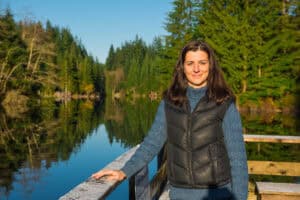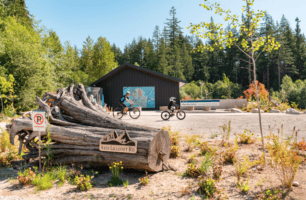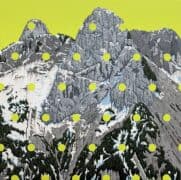Last month a community education and resource space was returned to the Lower Seymour Conservation Reserve (LSCR). A brand new Seymour Watershed Centre opened its doors to host future education and school groups.
Education to foster respect
The new Seymour Watershed Centre is a dual space housing some LSCR/Water treatment administration as well as acting as the home base for Metro Vancouver’s educational programming in the LSCR. Building on the legacy of the past Learning Lodge, Metro Vancouver is hoping public education brings a deeper understanding of our protected public lands.

Heidi Walsh
(courtesy Metro Vancouver)
“We really want people in the region to understand where their drinking water comes from and the relationship between a closed protected land and source water quality,” said Heidi Walsh, director of watersheds and environment, reflecting on the building’s unique position between the mountains and the filtration plant. “It’s easy to make the connection between the rain falling in the mountains then going through the filtration process and out to our taps.”
The new facility was created with an intentional educational design. Architects Local Practice aimed to nestle the building into the landscape while incorporating practical and educational features like cisterns.
“The way we have built it is to have a lot of the interpretive features outside the building,” said Walsh. “The map, the cisterns, and we have tried to incorporate some pipe into the seating. It is partially an outdoor classroom, so any member of the public passing by can learn about the watershed.”
Local Practice’s website explains the intention behind the design.
“The building is an educational tool for visitors to understand the relationship between our water source and water use. Rainwater is collected off the north side of the roof into the educational cistern, which overflows into channels for visitors to engage and play in the educational area. The rainwater from the south side of the roof is collected into the greywater cistern and it is used for toilet flushing to directly reduce the water consumption of the building. Any overflow water from either cistern travels through the bioswales and is returned to the natural hydrological cycle in the Lower Seymour Conservation Reserve.”
Ripple effects
Every year more than 6000 people come through Metro Vancouver’s education programs at Capilano, Coquitlam and Seymour watersheds.
“It’s about a 50/50 split between student classes and public watershed tours,” said Walsh.

(courtesy Metro Vancouver)
One of Metro Vancouver’s key education goals, says Walsh, is to foster respect and understanding of its ‘closed’ watersheds.
“A closed watershed is protected from pollution, development, from wildfire – which is a really big risk to the integrity of our watershed system,” said Walsh. “There are lots of people who think other water comes from wells or somewhere else.
“Our treatment design is based on the source water it gets. This design and infrastructure needs to treat water in our closed system. It is different from the infrastructure needed to treat water from a river or water that was open and people were boating, has cabins and septic fields. Protecting the land helps to simplify the process of our treatment.”
There are numerous reasons that Metro Vancouver developed the drinking water system using a closed system. Education is important to help residents understand the reasons there are substantial pieces of land set aside and protected. Top of mind this season is wildfires.
“There is a 65/45 split of lightning versus human-caused fires. If we lost the trees in one of the watersheds it would be devastating to the system,” said Walsh. “Our plants wouldn’t be able to keep up with ash and it would have to go offline and put pressure on the system that is designed to have all three watersheds functioning.
“We can keep that under really tight control when we can control who is coming in and what kind of activities are taking place. When our wildfire risk goes up, our activity level goes down.”
Walsh said she hopes that tours and facilities like the new Watershed Education Centre provide more people with understanding and respect for the reasons the areas are closed to the public.
The new Watershed Centre can be found adjacent to the bathrooms at the Rice Lake parking lot in the LSCR. Tours and education program listings can be found here. Walsh says there is hope the snowpack will allow for the return of snowshoe tours this winter.
Looking for more?
There’s always something fun and exciting happening in Lynn Valley. Check out our Community Events Calendar or learn more about Local Activities, Mountain Biking or Hiking and Walking Trails.


